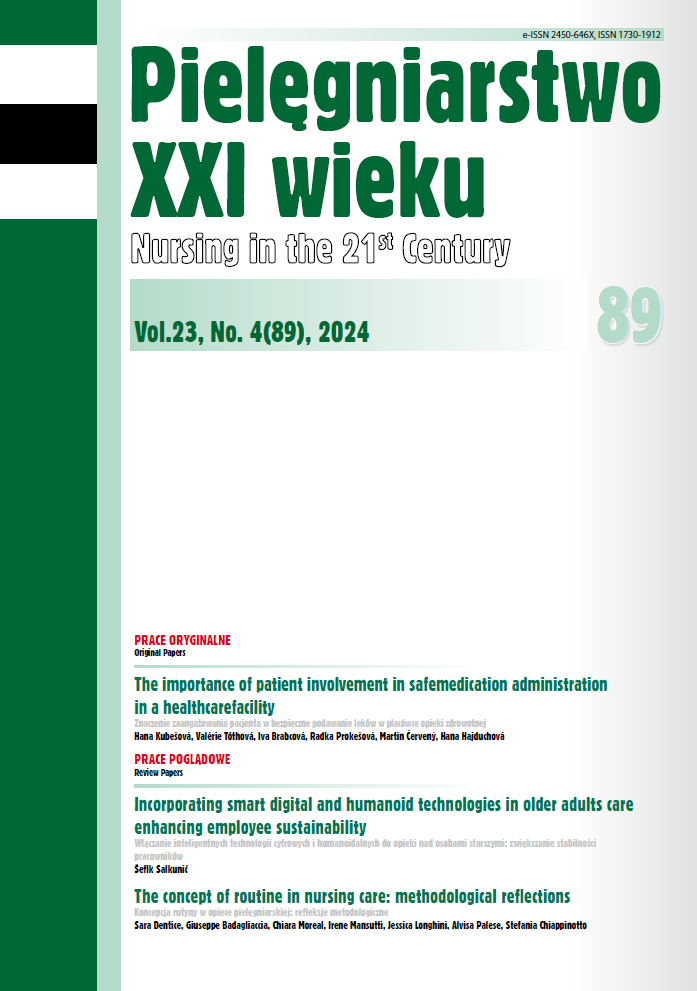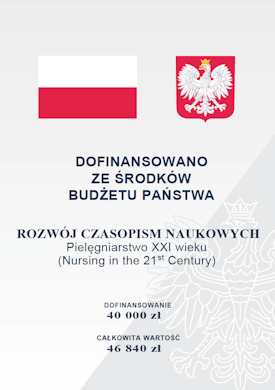The concept of routine in nursing care: methodological reflections
DOI:
https://doi.org/10.12923/pielxxiw-2024-0049Keywords:
routine care, usual care, standard of care, nursing practiceAbstract
ABSTRACT THE CONCEPT OF ROUTINE IN NURSING CARE: METHODOLOGICAL REFLECTIONS
Introduction. Routine is a common concept in nursing practice, often perceived as repetitive yet essential for ensuring effi ciency and consistency in care delivery. However, its role is complex, balancing between providing structure and hindering personalized care.
Aim. This paper explores the concept of routine across multiple disciplines, including sociology, psychology, and organizational studies, highlighting its implications in healthcare, nursing, and research.
Method. An overview of the literature.
Conclusions. Given the lack of conceptual clarity in the concept of routine, which may aff ect the development of nursing, recommendations on research are off ered.
References
1. Treccani [Internet]. [cited 2024 Apr 12]. routine - Treccani. Available from: https://www.treccani.it/vocabolario/routine/, https://www.treccani.it/vocabolario/routine/
2. Thesaurus.com [Internet]. 2024 [cited 2024 Apr 13]. Thesaurus.com - The world’sfavorite online thesaurus! Available from: https://www.thesaurus.com/browse/routine
3. Arlinghaus KR, Johnston CA. The importance of creating habits and routine. Am. J. Lifestyle Med. 2019; 13(2): 142-144.
4. Fiese BH, Tomcho TJ, Douglas M, et al. A review of 50 years of research on naturally occurring family routines and rituals: Cause for celebration? J. Fam. Psychol. 2002; 16(4): 381-390.
5. Rytterstrom P, Unosson M, Arman M. The signifi cance of routines in nursing practice. J. Clin. Nurs. 2011; 20(23-24): 3513-3522.
6. Zisberg A, Young HM, Schepp K, et al. A concept analysis of routine: relevance to nursing. J. Adv. Nurs. 2007; 57(4): 442-453.
7. Herrera CA, Juarez-Ramirez C, Reyes-Morales H, et al. COVID-19 disruption to routine health care services: How 8 Latin American and Caribbean Countries responded. Health Aff Proj. Hope. 2023; 42(12): 1667-1674.
8. Daly A, Teeling SP, Garvey S, et al. Using a combined lean and person-centred approach to support the resumption of routine hospital activity following the fi rst wave of COVID-19. Int. J. Environ. Res. Public Health. 2022; 19(5): 2754.
9. Delpino FM, da Silva CN, Jeronimo JS, et al. Prevalence of anxiety during the COVID-19 pandemic: A systematic review and meta-analysis of over 2 million people. J. Aff ect. Disord. 2022; 318: 272-282.
10. Gonella S, Di Giulio P, Palese A, et al. Randomized controlled trials and quasiexperimental studies published in nursing journals: fi ndings from a scoping review with implications for further research. Worldviews Evid Based Nurs. 2019; 16(4): 299-309.
11. McKinnon A. Ritual. In: Turner BS, editor. The Wiley‐Blackwell Encyclopedia of Social Theory [Internet]. 1st ed. Wiley; 2017 [cited 2024 Apr 13]. p. 1–2. Available from: https://onlinelibrary.wiley.com/doi/10.1002/9781118430873.est0318
12. Boyer P, Lienard P. Ingredients of ‘rituals’ and their cognitive underpinnings. Philos. Trans. R. Soc. Biol. Sci. 2020; 375(1805): 20190439.
13. Spagnola M, Fiese BH. Family routines and rituals: a context for development in the lives of young children. Infants Young Child. 2007; 20(4): 284-299.
14. Migliorini L, Rania N, Tassara T, et al. Family routine behaviors and meaningful rituals: a comparison between italian and migrant couples. Soc. Behav. Personal. Int. J. 2016; 44(1): 9-18.
15. Wood W, Runger D. Psychology of habit. Annu. Rev. Psychol. 2016; 67(1): 289-314.
16. Mazar A, Wood W. Defi ning Habit in Psychology. In: Verplanken B, editor. The Psychology of Habit [Internet]. Cham: Springer International Publishing; 2018 [cited 2024 Apr 13]. p. 13-29. Available from: http://link.springer.com/10.1007/978-3-319-97529-0_2
17. Lally P, Van Jaarsveld CHM, Potts HWW, et al. How are habits formed: Modelling habit formation in the real world. Eur. J. Soc. Psychol. 2010; 40(6): 998-1009.
18. Hagger MS. Habit and physical activity: Theoretical advances, practical implications, and agenda for future research. Psychol. Sport Exerc. 2019; 42: 118-129.
19. Trafi mow D. The Automaticity of Habitual Behaviours: Inconvenient Questions. In: Verplanken B, editor. The Psychology of Habit [Internet]. Cham: Springer International Publishing; 2018 [cited 2024 Apr 13]. p. 379-395. Available from: http://link.springer.com/10.1007/978-3-319-97529-0_21
20. Feldman MS, Pentland BT. Reconceptualizing organizational routines as a source of fl exibility and change. Adm. Sci. Q. 2003; 48(1): 94-118.
21. Becker MC, Zirpoli F. Applying organizational routines in analyzing the behavior of organizations. J. Econ. Behav. Organ. 2008; 66(1): 128-148.
22. Pentland BT. Organizational routines as a unit of analysis. Ind. Corp. Change. 2005; 14(5): 793-815.
23. Feldman MS. Organizational routines as a source of continuous change. Organ Sci. 2000; 11(6): 611-629.
24. Wolthuis F, Hubers MD, Van Veen K, et al. The concept of organizational routines and its potential for investigating educational initiatives in practice: a systematic review of the literature. Rev. Educ. Res. 2022; 92(2): 249-287.
25. Pentland BT, Harem T. Organizational routines as patterns of action: implications for organizational behavior. Annu. Rev. Organ. Psychol. Organ. Behav. 2015 Apr 10;2(1):465-87.
26. Almatrodi I, Skoumpopoulou D. Organizational routines and digital transformation: an analysis of how organizational routines impact digital transformation transition in a Saudi University. Systems. 2023; 11(5): 239.
27. Cooke BK, Worsham E, Reisfield GM. The elusive standard of care. J. Am. Acad. Psychiatry Law. 2017; 45(3): 358-364.
28. Vanderpool D. The Standard of Care. Innov. Clin. Neurosci. 2021; 18(7-9): 50-51.
29. WHO Guidelines for Safe Surgery 2009: Safe Surgery Saves Lives [Internet]. Geneva: World Health Organization; 2009 [cited 2024 Apr 13]. (WHO Guidelines Approved by the Guidelines Review Committee). Available from: http://www.ncbi.nlm.nih.gov/books/NBK143243/
30. Hazlehurst B, McMullen C. Orienting frames and private routines: The role of cultural process in critical care safety. Int. J. Med. Inf. 2007; 76: S129-135.
31. Leep‐Lazar K, Stimpfel AW. A dimensional analysis of nursing unit culture. J. Adv. Nurs. 2023 Nov 22; jan.15985.
32. Pearcey P. Tasks and routines in 21st century nursing: student nurses’ perceptions. Br. J. Nurs. Mark. Allen. Publ. 2007; 16(5): 296-300.
33. Phuthornchai K, Banharak S, Panpanit L, et al. Effects of symptom management program on selected health outcomes among older people with chronic obstructive pulmonary disease: a quasi-experimental study. Sci. Rep. 2023; 13(1): 22265.
34. Bowers BJ, Lauring C, Jacobson N. How nurses manage time and work in long‐term care. J. Adv. Nurs. 2001; 33(4): 484-491.
35. Willard C, Luker K. Challenges to end of life care in the acute hospital setting. Palliat. Med. 2006; 20(6): 611-615.
36. Levesque MH, Trepanier J, Sirois MJ, et al. Effets du Lifestyle Redesign chez les aines : une recension systematique. Can. J. Occup. Ther. 2019; 86(1): 48-60.
37. Pyatak EA, Carandang K, Rice Collins C, et al. Optimizing Occupations, Habits, and Routines for Health and Well-Being With Lifestyle RedesignR: A Synthesis and Scoping Review. Am. J. Occup. Ther. 2022; 76(5): 7605205050.
38. Equator Network. Reporting guidelines [Internet]. Available from: https://www.equator-network.org/reporting-guidelines/
39. Kosicka B, Ozdoba P, Dziurka M, et al. Experiential methods in ethical education of nursing and midwifery students. Pielęgniarstwo XXI Wieku. 2023; 22(3): 195-205. DOI: 10.2478/pielxxiw-2023-0024
40. Black K, Lobo M. A conceptual review of family resilience factors. J. Fam. Nurs. 2008; 14(1): 33-55.
41. Standard - Treccani - Treccani [Internet]. [cited 2024 May 3]. Available from: https://www.treccani.it/vocabolario/ricerca/standard/
42. Definition of standard of care - NCI Dictionary of Cancer Terms - NCI [Internet]. 2011 [cited 2024 May 3]. Available from: https://www.cancer.gov/publications/dictionaries/cancer-terms/def/standard-of-care
43. Treccani [Internet]. [cited 2024 May 3]. abituale - Treccani. Available from: https://www.treccani.it/vocabolario/ricerca/abituale/
44. Turner KM, Huntley A, Yardley T, et al. Defining usual care comparators when designing pragmatic trials of complex health interventions: a methodology review. Trials. 2024; 25(1): 117.
45. Page MJ, McKenzie JE, Bossuyt PM, et al. The PRISMA 2020 statement: an updated guideline for reporting systematic reviews. BMJ [Internet]. 2021 Mar 29 [cited 2024 Feb 14];n71. Available from: https://www.bmj.com/lookup/doi/10.1136/bmj.n71
46. Cochrane Handbook for Systematic Reviews of Interventions. Version 6.2 (updated February 2021). Cochrane Collaboration; 2021. Available from: https://training.cochrane.org/handbook
47. Schulz KF, Altman DG, Moher D, et al. CONSORT 2010 statement: updated guidelines for reporting parallel group randomised trials. BMJ. 2010 Mar 23;340:c332. doi: 10.1136/bmj.c332. PMID: 20332509; PMCID: PMC2844940.
48. Zwarenstein M, Treweek S, Gagnier JJ, et al. Improving the reporting of pragmatic trials: an extension of the CONSORT statement. BMJ. 2008 Nov 11;337:a2390. doi: 10.1136/bmj.a2390. PMID: 19001484; PMCID: PMC3266844.
49. Hemming K, Taljaard M, McKenzie JE, et al. Reporting of stepped wedge cluster randomised trials: extension of the CONSORT 2010 statement with explanation and elaboration. BMJ. 2018 Nov 9;363:k1614. doi: 10.1136/bmj.k1614. PMID: 30413417; PMCID: PMC6225589.
50. De Geest S, Zullig LL, Dunbar-Jacob J, Hughes D, Wilson IB, Vrijens B. Improving medication adherence research reporting: ESPACOMP Medication Adherence Reporting Guideline (EMERGE). Eur J Cardiovasc Nurs. 2019 Apr;18(4):258-259. doi:10.1177/1474515119830298. Epub 2019 Feb 10. PMID: 30739497; PMCID: PMC6433491.
51. Hoffmann TC, Glasziou PP, Boutron I, et al. Better reporting of interventions: template for intervention description and replication (TIDieR) checklist and guide. BMJ. 2014 Mar 7;348:g1687. doi: 10.1136/bmj.g1687. PMID: 24609605.
52. Duncan E, O’Cathain A, Rousseau N, et al. Guidance for reporting intervention development studies in health research (GUIDED): an evidence-based consensus study. BMJ Open. 2020;10. doi:10.1136/bmjopen-2019-033516.
53. Ogrinc G, Davies L, Goodman D, et al. SQUIRE 2.0 (Standards for QUality Improvement Reporting Excellence): revised publication guidelines from a detailed consensus process. BMJ Qual Saf. 2016 Dec;25(12):986-992. doi: 10.1136/bmjqs-2015-004411. Epub 2015 Sep 14. PMID: 26369893; PMCID: PMC5256233.
54. Pinnock H, Barwick M, Carpenter CR, et al. Standards for Reporting Implementation Studies (StaRI) Statement. BMJ. 2017 Mar 6;356:i6795. doi: 10.1136/bmj.i6795. PMID: 28264797; PMCID: PMC5421438.
55. Bossuyt PM, Reitsma JB, Bruns DE, et al. STARD 2015: an updated list of essential items for reporting diagnostic accuracy studies. BMJ. 2015 Oct 28;351:h5527. doi: 10.1136/bmj.h5527. PMID: 26511519; PMCID: PMC4623764.
56. von Elm E, Altman DG, Egger M, et al. The Strengthening the Reporting of Observational Studies in Epidemiology (STROBE) Statement: guidelines for reporting observational studies. Int. J. Surg. 2014 Dec;12(12):1495-9. doi: 10.1016/j.ijsu.2014.07.013. Epub 2014 Jul 18. PMID: 25046131.
Downloads
Published
Issue
Section
License
Copyright (c) 2025 Authors

This work is licensed under a Creative Commons Attribution 4.0 International License.




